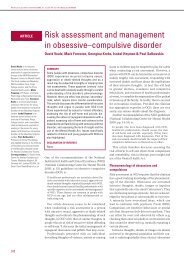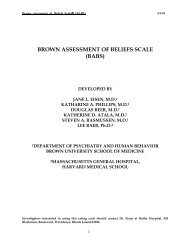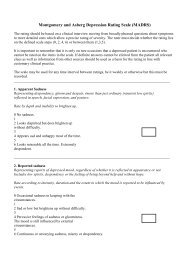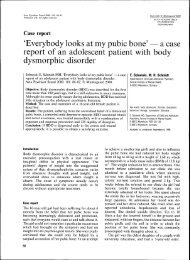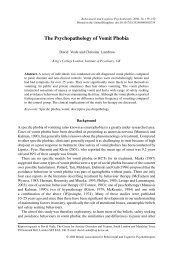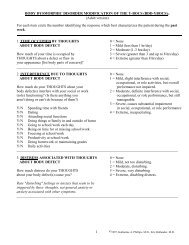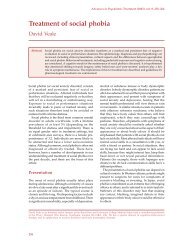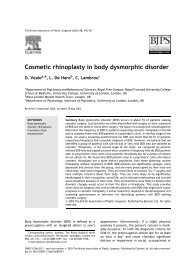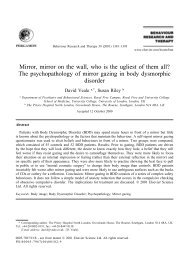Cognitive behaviour therapy for a specific phobia of vomiting
Cognitive behaviour therapy for a specific phobia of vomiting
Cognitive behaviour therapy for a specific phobia of vomiting
Create successful ePaper yourself
Turn your PDF publications into a flip-book with our unique Google optimized e-Paper software.
282 D. VealePeople with a SPOV may recognize the low probability <strong>of</strong> the likelihood <strong>of</strong> <strong>vomiting</strong> butcontinue to believe that the awfulness <strong>of</strong> <strong>vomiting</strong> is too great and do everything they believenecessary to stop themselves from <strong>vomiting</strong> (or even thinking about it). In this respect it hassimilarities with an over-inflated sense <strong>of</strong> responsibility and the need <strong>for</strong> certainty as in OCD(Salkovskis et al. 2000). Many clients say that they would prefer to be in control and die ratherthan vomit. For this reason it may be more helpful to focus the individual on what she reallywants her life to represent – rather than being someone whose life is dedicated to not <strong>vomiting</strong>or to following the values that were identified in her assessment. A person with SPOV is beingasked to act as if they do not have a SPOV even if they believe that <strong>vomiting</strong> is awful orlife threatening. This has many implications in trying to give up control over <strong>vomiting</strong> andaccepting the uncertainty that <strong>vomiting</strong> may occur. It is helpful to explore the meaning orimagery associated with ‘losing control’ (e.g. the idea <strong>of</strong> not being able to prevent oneselffrom <strong>vomiting</strong> and the <strong>vomiting</strong> persisting). A major step <strong>for</strong> the client is accepting that ifher body needs to vomit (e.g. food poisoning) then there is very little control in preventing<strong>vomiting</strong> (and it would be dangerous if one could inhibit removal <strong>of</strong> toxins). One can partlydemonstrate magical thinking by a <strong>behaviour</strong>al experiment in which the client is encouragedto wish herself <strong>vomiting</strong> when she feels nauseous or bloated. It is also possible to demonstratethe lack <strong>of</strong> control over intrusive thoughts and images <strong>of</strong> <strong>vomiting</strong> by standard thoughtcontrol experiments (e.g. try not to think <strong>of</strong> a ‘pink elephant’). The message is that tryingto control thoughts or feelings <strong>of</strong> <strong>vomiting</strong> is the problem that increases distress and not thesolution.For the client, the fear <strong>of</strong> losing control is related to the need <strong>for</strong> certainty that she is notgoing to vomit. As in OCD, this is questioned by pragmatism. There is no guarantee thatwhatever a person with SPOV does in <strong>therapy</strong> to overcome her fears will not be associatedwith <strong>vomiting</strong> (or it may occur by coincidence <strong>for</strong> another reason). However, the cost <strong>of</strong> failureto overcome her fear and trying to prevent herself from <strong>vomiting</strong> is the guarantee that she willbe disturbed by a SPOV <strong>for</strong> the rest <strong>of</strong> her life and be unable to follow her valued directionsin life.Exposure in vivoThe evidence-based treatment <strong>for</strong> <strong>specific</strong> <strong>phobia</strong>s is graded exposure in vivo. Graded exposureinvolves a hierarchy that is negotiated and exposure done in vivo within sessions or ashomework alone or with the assistance <strong>of</strong> a relative or friend. The choice <strong>of</strong> cues <strong>for</strong> exposurewill there<strong>for</strong>e be guided by the assessment, the hierarchy <strong>of</strong> cues and <strong>for</strong>mulation. Some valueddirections such as the need to increase weight or to be an effective parent <strong>for</strong> child care mayalso determine the priority <strong>of</strong> which tasks take greater priority.The guiding principle <strong>for</strong> graded exposure in vivo in SPOV is to choose both (a) internal cues<strong>of</strong> <strong>vomiting</strong> (e.g. past memories <strong>of</strong> <strong>vomiting</strong>, thoughts, images or sensations associated with<strong>vomiting</strong>), (b) external cues <strong>for</strong> <strong>vomiting</strong> that are being avoided or devised <strong>for</strong> the treatmentprogramme (e.g. smell <strong>of</strong> vomit). Graded exposure needs to be done without safety-seeking<strong>behaviour</strong>s, self-focused attention and other attentional biases in monitoring nausea and othergastrointestinal symptoms. It needs to be done continuously until the anxiety has effectivelysubsided. Last, exposure means full acceptance that one has very limited control <strong>of</strong> anyintrusive thoughts or images <strong>of</strong> the idea <strong>of</strong> oneself <strong>vomiting</strong> in the future. An example <strong>of</strong> anexposure hierarchy is shown in Table 2 and the client’s history is given below.



